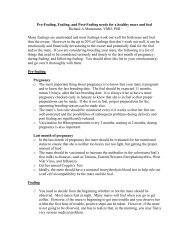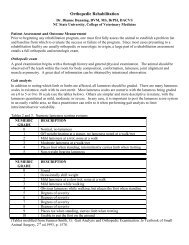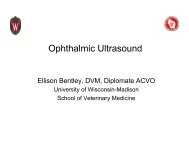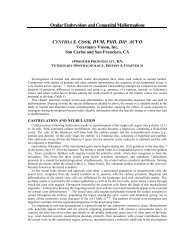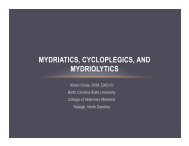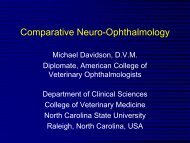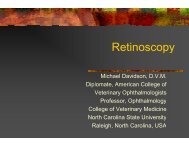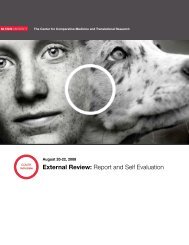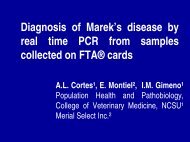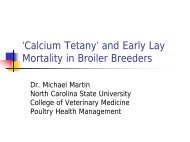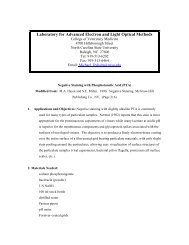TEAR SUBSTITUTES Polysaccharides and Vinyl Derivatives
TEAR SUBSTITUTES Polysaccharides and Vinyl Derivatives
TEAR SUBSTITUTES Polysaccharides and Vinyl Derivatives
Create successful ePaper yourself
Turn your PDF publications into a flip-book with our unique Google optimized e-Paper software.
<strong>TEAR</strong> <strong>SUBSTITUTES</strong> AND STIMULATORS<br />
Alison Clode, DVM, DACVO<br />
North Carolina State University<br />
College of Veterinary Medicine<br />
Raleigh, North Carolina 27607<br />
<strong>TEAR</strong> <strong>SUBSTITUTES</strong><br />
Solutions <strong>and</strong> ointments meant to substitute for inadequate quantity or quality of the precorneal tear<br />
film serve a variety of functions, with the (temporary) restoration of ocular comfort being one of the most<br />
significant. Additionally, optical clarity is restored <strong>and</strong> the overall ability of the surface epithelium to serve as<br />
an effective protective barrier for the eye is restored. Various molecular properties are considered in the<br />
development of tear replacers, with the goal being to mimic the natural precorneal tear film as closely as<br />
possible. Such properties include the surface tension, which enables a solution or ointment to efficiently cover<br />
the ocular surface when the eyelids are open while not restricting effective eyelid movement; the effect of<br />
surfactants (i.e., mucin) on this surface tension; pH (slightly alkaline solutions are frequently more comfortable<br />
than isotonic or acidic solutions); buffering; osmolality (mOsm/kg; higher osmolality is more beneficial); <strong>and</strong><br />
osmolarity (mosm/L; lower osmolarity is frequently more comfortable). Additionally, the presence or absence<br />
of preservatives in such solutions is important, as more frequent application results in more exposure to <strong>and</strong><br />
potential toxicity from added preservatives (benzalkonium chloride [BAK], chlorobutanol, sodium perborate,<br />
ethylenediaminetetraacetic acid [EDTA], polyquaternium, methylparaben, <strong>and</strong> propylparaben).<br />
Most artificial tear preparations are water-based. Overall tear film stability is enhanced by addition of<br />
polymers to increase viscosity, lubrication, <strong>and</strong> retention time. The polymers frequently used include<br />
methylcellulose, polyvinyl alchohol, povidone, dextran, <strong>and</strong> propylene glycol. Other agents, such as gelatin,<br />
glycerin, polyethylene glycol, poloxamer 407, <strong>and</strong> polysorbate 80, may also increase viscosity. Tonicity <strong>and</strong><br />
pH stabilization are provided by ions such as sodium chloride, potassium chloride, <strong>and</strong> boric acid.<br />
<strong>Polysaccharides</strong> <strong>and</strong> <strong>Vinyl</strong> <strong>Derivatives</strong><br />
These include dextran, cellulose ethers, viscoelastic agents, <strong>and</strong> vinyl derivatives.<br />
Cellulose ethers<br />
Methylcellulose (MC), hydroxypropylcellulose, hydroxypropylmethylcellulose (HPMC), <strong>and</strong><br />
carboxymethylcellulose are the most commonly encountered cellulose ethers. As a group, they increase the<br />
viscosity of tear replacement solutions without altering the refractive index of the cornea or causing ocular<br />
toxicity. MC is utilized at concentrations of 0.25% to 1%, which provide good viscosity at physiologic pH.<br />
HPMC <strong>and</strong> other cellulose ethers are less viscous than MC, but maintain cohesive <strong>and</strong> emollient properties<br />
similar to or better than those of MC. As a class, these are inert chemicals that mix well with other drugs, <strong>and</strong><br />
appear to have tear film stabilizing ability, enhancing their overall action. Additionally, MC tolerates the high<br />
temperatures of heat sterilization with no adverse affects.<br />
Viscoelastic agents<br />
Sodium hyaluronate <strong>and</strong> chondroitin sulfate are mucopolysaccharides frequently utilized in intraocular<br />
surgery. Both are naturally occurring polymers <strong>and</strong> sodium hyaluronate is involved in wound healing,<br />
providing therapeutic benefit beyond that related to viscosity alone. Sodium hyaluronate does not appear to<br />
sufficiently stabilize the precorneal tear film relative to other polymers, <strong>and</strong> it is more expensive than other<br />
polymers, however concentrations for topical administration are generally lower than those for intraocular use.<br />
A study comparing use of 10% chondroitin sulfate/ 0.3% tobramycin with 20% chondroitin<br />
sulfate/0.3% ciprofloxacin as treatment for dogs with ulcerative keratitis associated with either spontaneous<br />
chronic corneal epithelial defect syndrome (SCCED) or bullous keratopathy (BK) found a greater percent<br />
healing in dogs receiving either medication for treatment of SCCED than for BK (53.6% versus 17.6% at two<br />
weeks, respectively). 1 There were differences in the duration of disease prior to referral <strong>and</strong> inclusion in the
study between the two groups, <strong>and</strong> there was no control group, which may have allowed better assessment of<br />
the individual effects of the chondroitin sulfate alone.<br />
<strong>Vinyl</strong> derivatives<br />
<strong>Vinyl</strong> derivatives are water-soluble polymers, with polyvinyl alcohol (PVA) being the most commonly<br />
used. The viscosity of PVA is less than that of previously mentioned substances, however it has good retention<br />
time because of highly adsorptive properties, <strong>and</strong> likely also stabilizes the tear film in a manner similar to MC<br />
<strong>and</strong> HPMC, as manifested by an increased tear film breakup time. It can withst<strong>and</strong> high temperatures, making<br />
heat sterilization possible. Its primary drawback is the potential for PVA-containing solutions to coagulate<br />
when combined with sodium bicarbonate, sodium borate, <strong>and</strong> sulfates of sodium, potassium, <strong>and</strong> zinc.<br />
Polyvinylpyrrolidone (PVP) is a vinyl derivative that is used to increase viscosity of solutions, <strong>and</strong><br />
may also have adsorptive properties similar to those of naturally-occurring mucin.<br />
Other Viscosity-Enhancing Agents<br />
Hydroxypropyl guar (HP-Guar), found in Systane eye drops, is a high-molecular-weight branched<br />
polymer of mannose <strong>and</strong> galactose. Its lubricant properties come from its ability to mimic mucin in tears, as<br />
well as to prolong contact time <strong>and</strong> rentention of polyethylene glycol 400 <strong>and</strong> propylene glycol (two viscosityenhancing<br />
agents). At ph 7.0, HP-Guar is a liquid, but it is a gel at normal tear film pH 7.5. When transitioned<br />
to a gel, a matrix forms which promotes adhesion of viscosity-enhancing agents, <strong>and</strong> provides mechanical<br />
protection of the ocular surface.<br />
Other components of tear replacement solutions<br />
Electrolytes<br />
Electrolytes serve to maintain the osmolarity of artificial tear preparations, <strong>and</strong> also provide nutrients<br />
for epithelial metabolism. Tear preparations are either isotonic or hypotonic to natural tears, as hypertonic<br />
solutions would attract water from the epithelial cells, potentially increasing damage associated with tear film<br />
deficiency in the first place. Hyperosmolarity may also be part of the underlying pathophysiology of ocular<br />
surface disorders, therefore hypotonic solutions may serve to dilute out tears in such cases. Both isotonic <strong>and</strong><br />
hypotonic tear replacement solutions appear to provide similar therapeutic benefit.<br />
Buffers<br />
Normal tear film pH is approximately 7.5, however slightly alkaline tear replacement solutions (ph<br />
8.5) are generally preferred when treating dry eye. Use of phosphate, phosphate-acetate, phosphate-citrate,<br />
phosphate-citrate-bicarbonate, borate, <strong>and</strong> sodium hydroxide help to achieve slightly alkalinity.<br />
Preservatives<br />
Preservatives are necessary to kill or inhibit growth of microorganisms in multi-dose vials.<br />
Benzalkonium hydrochloride (BAK), polyquaternium, thimerosal, chlorobutanol, methylparaben,<br />
propylparaben, <strong>and</strong> EDTA are examples. While these are necessary to prevent transmitting infection to the<br />
ocular surface, they are known to induce epithelial toxicity, disrupt tear film stability, <strong>and</strong> cause hypersentivity<br />
reactions. It is recommended that if administration of a tear replacment formulation is necessary four or more<br />
times a day, a preservative-free preparation be used. Newer preservatives are being developed that preserve the<br />
medication within the bottle, but then break down to nontoxic substances when exposed to light or the ocular<br />
surface.<br />
Nutrients<br />
Nutrients supplied in tear replacement solutions include water, dextrose, sodium lactate, sodium<br />
citrate, <strong>and</strong> vitamins A, B 12 , <strong>and</strong> C.<br />
Mucolytic agents (Acetylcysteine)
Mucolytics function to make existing mucus more fluid, <strong>and</strong> also to improve the quality <strong>and</strong><br />
production of mucus from goblet cells.<br />
<strong>TEAR</strong> STIMULANTS<br />
Tear stimulants, also known as secretagogues or lacrimomimetics, are used to actually increase tear<br />
production in patients with at least some degree of remaining functional lacrimal tissue.<br />
Pilocarpine<br />
Pilocarpine is a cholinergic (muscarinic) agonist that mimics acetylcholine at the effector cell (lacrimal<br />
cell) level, directly stimulating tear production. Topical pilocarpine produces no significant nor long-term<br />
elevation in tear production in normal dogs, <strong>and</strong> produces signs of ocular discomfort following instillation,<br />
making it an ineffective topical treatment for keratoconjunctivitis sicca (KCS). Administered orally,<br />
pilocarpine may have beneficial effects on tear production, particularly in animals with neurogenic KCS. In<br />
those patients, the lacrimal gl<strong>and</strong> tissue is presumably normal, however stimulation is absent (<strong>and</strong> therefore can<br />
be provided directly by pilocarpine). Controlled studies regarding use of pilocarpine in this manner have not<br />
been performed. Clinical signs associated with toxicity include profuse salivation, lacrimation, urination,<br />
defecation, <strong>and</strong> diarrhea (SLUDDs), typical of parasympathetic overstimulation. A starting dose is typically 1<br />
drop of 2% ophthalmic pilocarpine per 20 pounds twice daily, administered in the food. The dose is increased<br />
by 1 drop per day every 2-3 days until either clinical improvement is seen (increased STT values) or signs of<br />
systemic toxicity develop. If toxicity develops, the dose should be decreased.<br />
Cyclosporin<br />
Cyclosporin is an immunosuppressive medication which has multiple mechanisms of action that<br />
improve clinical signs <strong>and</strong> tear production in dogs affected with KCS. T-cell suppression decreases immunemediated<br />
attack on the lacrimal gl<strong>and</strong> <strong>and</strong> increases lymphocyte apoptosis, while decreasing apoptosis of<br />
lacrimal gl<strong>and</strong>ular cells <strong>and</strong> conjunctival epithelium. Conjunctival mucin stores are increased, leading to a<br />
qualitative improvement in the tear film as well. 2 A direct lacrimomimetic effect has also been postulated.<br />
Cyclosporin may be administered as a 0.2% ointment (Optimmune ® ), or as solutions compounded in<br />
various oils, generally in either 1% or 2% formulations, <strong>and</strong> is generally administered twice daily. STT results<br />
may take weeks to months to return to normal, <strong>and</strong> patients with initial STT measurements of >2 mm<br />
wetting/min more slightly to experience a favorable response than patients with STT measurements between 0<br />
<strong>and</strong> 2 mm wetting/min. 3 In addition to or independently of improvement in STT results, corneal vascularization<br />
<strong>and</strong> pigmentation may decrease as well. 4 Ocular side effects may include irritation, which is self-limiting <strong>and</strong><br />
often improves with therapy. Systemic side effects may include reduced circulating lymphocyte numbers <strong>and</strong><br />
suppression of lymphocyte proliferation, however these variables do not seem to correlate to clinical sequelae of<br />
immunosuppression. 5,6<br />
Tacrolimus<br />
Tacrolimus (FK506) is a macrolide antibiotic with an immunosuppressive mechanism similar to that of<br />
cyclosporin (discussed elsewhere). When used in dogs newly diagnosed with KCS with an initial STT ≤10<br />
mm/min, 83% of patients experienced an increase ≥5 mm/min within a mean of 6 weeks, while 25% of dogs<br />
newly diagnosed with KCS with an initial STT 11-15 mm/min experienced an increase ≥5 mm/min within a<br />
mean of ~5 weeks. 7 In the same study, after receiving tacrolimus for approximately 2 months, 27% of dogs with<br />
KCS who previously exhibited a positive response to cyclosporin <strong>and</strong> 51% of dogs with KCS previously<br />
unresponsive to cyclosporin experienced an additional increase in STT of ≥5 mm/min.<br />
Pimecrolimus<br />
Pimecrolimus has a similar mechanism of action to that of tacrolimus, with greater sensitivity<br />
(mechanism discussed elsewhere). An uncontrolled evaluation of pimecrolimus 1%, administered three times<br />
daily to clinical patients with KCS or chronic superficial keratitis (CSK) documented a favorable clinical<br />
response in 10 of 14 animals, marked by an increase in STT <strong>and</strong> reduction in signs of corneal inflammation <strong>and</strong>
scarring. 8 A study comparing the effects of 1% pimecrolimus with those of 0.2% cyclosporin in dogs with KCS<br />
found pimecrolimus resulted in comparable improvement in STT <strong>and</strong> clinical signs over the 8-week study<br />
period to those documented with cyclosporin. 9<br />
References<br />
1. Ledbetter E, Munger R, Ring R, et al. Efficacy of two chondroitin sulfate ophthalmic solutions in the<br />
therapy of spontaneous chronic corneal epithelial defects <strong>and</strong> ulcerative keratitis associated with bullous<br />
keratopathy in dogs. Veterinary Ophthalmology 2006;9:77-87.<br />
2. Moore M, Cherrington A, Palmer B, et al. Effect of cyclosporine on conjunctival mucin in a canine<br />
keratoconjunctivitis sicca model. Investigative Ophthalmology <strong>and</strong> Visual Science 2001;42:653-659.<br />
3. Kaswan R, Salisbury M, Ward D. Spontaneous canine keratoconjunctivitis sicca. A useful model for<br />
human keratoconjuncitivitis sicca: Treatment with cyclosporine eye drops. Archives of Ophthalmology<br />
1989;107:1210-1216.<br />
4. Kaswan R, Martin C, Chapman W. Keratoconjunctivitis sicca: Histopathologic study of nictitating<br />
membrane <strong>and</strong> lacrimal gl<strong>and</strong> from 28 dogs. American Journal of Veterinary Research 1984;45:112-118.<br />
5. Gilger B, Andrews J, Wilkie D, et al. Lymphocyte proliferation <strong>and</strong> blood drug levels in dogs with<br />
keratoconjunctivitis sicca receiving long-terms topical ocular cyclosporine. Veterinary Comparative<br />
Ophthalmology 1996;6:125-130.<br />
6. Gilger B, Andrews J, Wilkie D, et al. Cellular immunity in dogs with keratoconjunctivitis sicca before<br />
<strong>and</strong> after treatment with topical 2% cyclosporine. Veterinary Immunology <strong>and</strong> Immunopathology 1995;49:199-<br />
208.<br />
7. Berdoulay A, English R, Nadelstein B. Effect of topical 0.02% tacrolimus aqueous suspension on tear<br />
production in dogs with keratoconjunctivitis sicca. Veterinary Ophthalmology 2005;8:225-232.<br />
8. Nell B, Walde I, Billich A, et al. The effect of topical pimecrolimus on keratoconjunctivitis sicca <strong>and</strong><br />
chronic superficial keratitis in dogs: results from an exploratory study. Veterinary Ophthalmology 2005;8:39-<br />
46.<br />
9. Ofri R, Lambrou G, Allgoewer I, et al. Clinical evaluation of pimecrolimus eye drops for treatment of<br />
canine keratoconjunctivitis sicca: A comparison with cyclosporine A. The Veterinary Journal 2009;79:7-077.



